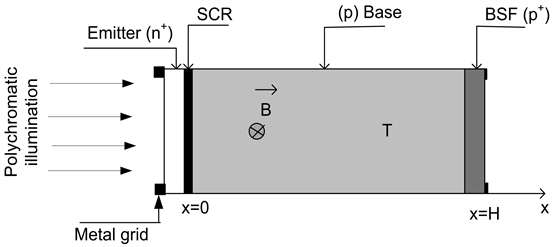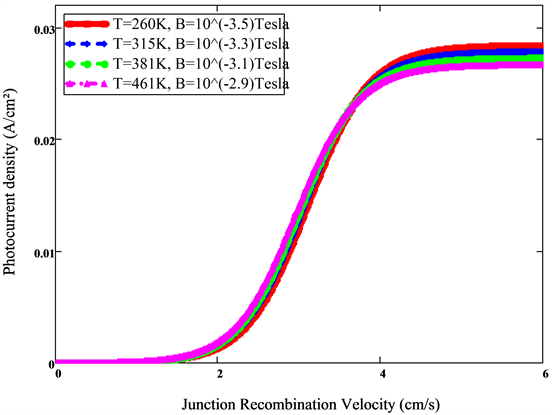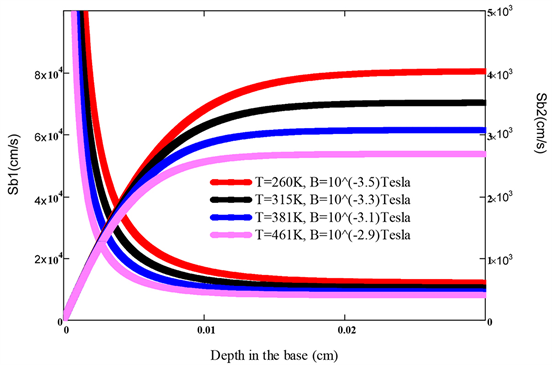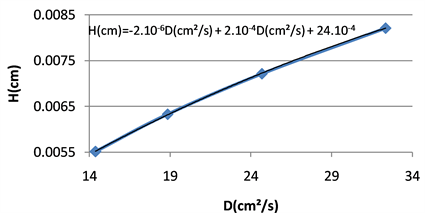Journal of Modern Physics
Vol.10 No.13(2019), Article ID:96558,10 pages
10.4236/jmp.2019.1013105
Influence of Both Magnetic Field and Temperature on Silicon Solar Cell Base Optimum Thickness Determination
Nouh Mohamed Moctar Ould Mohamed1, Ousmane Sow2, Sega Gueye1, Youssou Traore1, Ibrahima Diatta1, Amary Thiam1, Mamour Amadou Ba1, Richard Mane1, Ibrahima Ly3, Gregoire Sissoko1
1Laboratory of Semiconductors and Solar Energy, Physics Department, Faculty of Science and Technology, University Cheikh Anta Diop, Dakar, Senegal
2University Institute of Technology, University of Thiès, Thiès, Sénégal
3Ecole Polytechnique de Thiès, Thiès, Sénégal

Copyright © 2019 by author(s) and Scientific Research Publishing Inc.
This work is licensed under the Creative Commons Attribution International License (CC BY 4.0).
http://creativecommons.org/licenses/by/4.0/



Received: October 29, 2019; Accepted: November 22, 2019; Published: November 25, 2019
ABSTRACT
The minority carrier’s recombination velocity at the junction and at the back surface is used for the modeling and determination of the optimum thickness of the base of a silicon solar cell in the static regime, under magnetic field and temperature influence. This study takes into account the Umklapp process and the Lorentz effect on the minority carriers photogenerated in the base.
Keywords:
Silicon Solar Cell, Diffusion Coefficient, Surface Recombination Velocity, Optimum Base Thickness, Lorentz and Umklapp Processes

1. Introduction
The parameters of the electric equivalent model of the solar cell, under darkness or illumination lead to its characterization, through the measurement of electrical current and voltage (I-V) [1].
These measurements are made by maintaining the solar cell under static [2] [3] or dynamic (transient [4] [5] [6] or frequency [7] [8] [9]) regimes and thus defining the different characterization technics.
From these technics, the series (Rs) [10] [11] [12] and shunt (Rsh) [13] [14] [15] resistances are deduced, which allow appreciating the quality of the solar cell, as well as the capacitance of transition.
However, these parameters are not expressed as function of solar cell geometrical parameters, especially the thicknesses of emitter, space charge region, base, and grain size [16].
In this work, the phenomenological parameters, such as minority carrier recombination velocity [17] [18] in the bulk (τ) [19], at the emitter-base junction (Sf) and at the back surface (Sb) [20] [21] of the base with thickness (H), are studied to extract the optimum thickness H, of the base of the silicon solar cell, placed under magnetic field B and with variation of the temperature T. This optimum thickness is obtained from the curves of the back surface recombination velocity, expressed as dependent of both the diffusion coefficient D(T, B) [22] [23] revealing the Umklapp process [24] and the base thickness.
2. Theory
Figure 1 represents a n+-p-p+ silicon solar cell under polychromatic illumination, by the emitter (n+), through the collected grids. The space charge region (SCR), in x = 0, constitutes the junction (n+-p), allowing the separation of photogenerated electron-hole pairs. The rear face (p+), in x = H, is a zone where an electric field exists (Back surface Field), which allows the return of the minority charge carriers towards the junction [25] [26].
When the solar cell is under illumination, the density δ(x, T, B) of photogenerated carriers in the base under magnetic field B at temperature T, is governed by the following magneto transport equation.
(1)
et D(T, B) are, respectively, the lifetime and the diffusion coefficient of the excess minority carriers in the base, under magnetic field and under temperature.
Under magnetic field, the diffusion coefficient is given by the following relation [27]:
Figure 1. The solar cell structure to the n+-p-p+ type, under both magnetic field and temperature.
(2)
With
(3)
And the mobility coefficient is given as [28]:
(4)
L represents the diffusion length of minority carriers in excess. Plot of expression (2) allows to extract maximum diffusion coefficient which is related to optimum temperature by following relation [23]:
(5)
With
(6)
and
(7)
the density of photogenerated carriers in the base, is produced by the generation rate, expressed by [29]:
(8)
where n is the number of sun or level of illumination.
The parameters ai et bi stem from the modeling of the incident illumination as defined under A.M1.5.
The expression of the excess minority carrier density in the base is given by the resolution of the continuity equation and is written as:
(9)
where
(10)
and are coefficients determined from the boundary conditions which respectively introduce the surface recombination velocity at the junction (Sf) and at the rear face (Sb).
1) At the junction x = 0 (SCR)
(11)
Sf indicates the velocity of passage of the charge carriers across the junction, to the emitter. This velocity of passage of the minority carriers is governed by the external charge resistance conncted to the solar cell which imposes the operating point [19] [20] [21]. Thus, the carriers that have crossed through the junction and are not collected, constitute the losses through the shunt resistance, associated with the intrinsic minority carriers velocity Sf0, at the junction [4] [9] [20].
2) At the back surface
(12)
H is the thickness of the base of the solar cell.
Sb is the back surface recombination velocity of the excess minority carrier [20] [21] [25] [30], at coordinate x = H, where exists a rear electric field (p/p+, low-high junction), which returns the carriers toward the junction (SCR), to be collected.
3. Results and Discussions
3.1. Photocurrent Density
Fick’s law allows us to obtain the expression of the photocurrent density. This expression is given by the following equation:
(13)
Figure 2 gives the profile of the photocurrent density versus minority carrier recombination velocity at the junction for different values of both, temperature and magnetic field according to Equation (5).
For values of Sf < 102 cm/s, the photocurrent is practically nil (whatever the temperature and magnetic field), which corresponds to an open circuit operating point of the solar cell. Between 104 cm/s and 105 cm/s, the photocurrent is increasing.
For Sf beyond 105 cm/s, the photocurrent is constant with Sf and corresponds to the short-circuit current density Jphsc, which is a plateau that increases with the temperature and decreases with magnetic field (Lorentz’s law).
3.2. Back Surface Recombination Velocity Sb (T, B)
Figure 2 indicates a plateau regardless of Sf, so the derivative of the expression of the photocurrent density with respect to the recombination velocity, is zero. [17] [20] [21] and is written
Figure 2. Photocurrent density calibration curves versus minority carrier recombination velocity at the junction under temperature and magnetic field.
(16)
The resolution of this equation leads to following expressions of back surface recombination velocity Sb1 (H, D) and Sb2 (H, D):
(17)
where in Sb1 expression, appears the effect of light absorption (bi coefficient) in the material and leads to a generation rate ( , for L >> H) [20] [21], [23]. Given Fick’s law on the back surface, the Sb2 (<0) expression is the intrinsic minority carriers recombination velocity at the back surface [22].
(18)
Sb1 and Sb2 lead asymptotically to the quotient D/L, which is the diffusion velocity (for L << H) [20], [21].
Figure 3 gives the profile of the two expressions of minority carrier recombination velocity at the rear face versus the solar cell base thickness, for different diffusion coefficient Dmax(B, T) values of the minority carriers in the base undergoing the Umklapp (thermal agitation) and Lorent processes(defection) [23] [24].
Figure 3. Back surface recombination velocity curves versus solar cell base thickness.
The intersection of the curves Sb1 and Sb2, has for abscissa, the optimum thickness of the base of the solar cell for each diffusion coefficient Dmax(B, Topt) [23].
Table 1 summarizes the variation of the solar cell base thickness for each diffusion coefficient (Dmax(B, Topt)) and the respective short-circuit currents Jsc1 and Jsc2 which remain maximum and constant.
Figure 4 and Figure 5, give the representation of the thickness of the base of the solar cell necessary for each case of the diffusion coefficient. The correlation between the diffusion coefficient Dmax(T, B) and the optimum base thickness is established.
The current-voltage characteristics, under constant illumination of the solar cell having different base thicknesses, are simulated and the efficiency is obtained according to the thickness and under the influence of the surface recombination velocity [31]. The influence of thickness is highlighted in dynamic regime [16] [30] [32] through the constant decay time, as well as in studies of the solar cell in 3D model [24] [33] [34] where the electrical (D, Sf, Sb) [35] [36] and geometry (grain size) [37] parameters are involved.
Thus the results we propose in this work, constitute a contribution for the modelling and manufacturing of the solar cell thickness, for optimum efficiency under specific operating conditions [36].
4. Conclusion
The proposed study on determining the optimum thickness of the base of a silicon solar cell under temperature and magnetic field, takes into account the behaviour of minority carriers in physical processes of thermal agitation (Umklapp) and deflection (Lorentz). These physical mechanisms are quantified through the diffusion coefficient and recombination velocity of minority carriers
Table 1. Base optimum thickness Value (H) for different diffusion coefficients Dmax(B, Topt).
Figure 4. Base depth H as function of logarithm of diffusion coefficient.
Figure 5. Base depth H as function of diffusion coefficient.
at the back surface. Thus, the study of the photocurrent obtained from the solar cell in short-circuit operation, allows extracting the theoretical expressions of the recombination velocity at the back surface of the base. The optimum thickness is then deduced through the analysis of the profile of these two expressions of minority carrier recombination velocity versus thickness, represented by the intercept points. The optimum thickness required for the manufacturing of the base is then established. Thus, solar cell can operate under (T, B) conditions and yield optimum efficiency.
Conflicts of Interest
The authors declare no conflicts of interest regarding the publication of this paper.
Cite this paper
Mohamed, N.M.M.O., Sow, O., Gueye, S., Traore, Y., Diatta, I., Thiam, A., Ba, M.A., Mane, R., Ly, I. and Sissoko, G. (2019) Influence of Both Magnetic Field and Temperature on Silicon Solar Cell Base Optimum Thickness Determination. Journal of Modern Physics, 10, 1596-1605. https://doi.org/10.4236/jmp.2019.1013105
References
- 1. Sow, O., Zerbo, I., Mbodji, S., Ngom, M.I., Diouf, M.S. and Sissoko, G. (2012) International Journal of Science, Environment and Technology, 1, 230-246.
- 2. Diasse, O., Diao, A., Wade, M., Diouf, M., Diatta, I., Mane, R., Traore, Y. and Sissoko, G. (2018) Journal of Modern Physics, 9, 189-201. https://doi.org/10.4236/jmp.2018.92012
- 3. Barro, F.I., Gaye, S., Deme, M., Diallo, H.L., Samb, M.L., Samoura, A.M., Mbodji, S. and Sissoko, G. (2008) Influence of Grain Size and Grain Boundary Recombination Velocity on the Series and Shunt Resistances of a Poly-Crystalline Silicon Solar Cell. Proceedings of the 23rd European Photovoltaic Solar Energy Conference, Valencia, 1-5 September 2008, 612-615.
- 4. Kalidou Mamadou, S.Y., Diene, A., Tamba, S., Diouf, M.S., Diatta, I., Dieye, M., Traore, Y. and Sissoko, G. (2016) Journal of Scientific and Engineering Research, 3, 433-445.
- 5. Gaye, I., Corréa, A., Ba, B., Ndiaye, A.L., Nanéma, E., Ba, A.B.B., Adj, M. and Sissoko, G. (1996) Renewable Energy, 3, 1598-1601.
- 6. Corréa, A., Gaye, I., Ba, B., Ndiaye, A.L. and Sissoko, G. (1994) Renewable Energy, 5, 166-168. https://doi.org/10.1016/0960-1481(94)90366-2
- 7. Traore, Y., Thiam, N., Thiame, M., Thiam, A., Ba, M.L., Diouf, M.S., Diatta, I., Mballo, O., Sow, E.H., Wade, M. and Sissoko, G. (2019) Journal of Modern Physics, 10, 1235-1246. http://www.scirp.org/journal/jmphttps://doi.org/10.4236/jmp.2019.1010082
- 8. Gueye, M., Diallo, H.L., Moustapha, A.K.M., Traore, Y., Diatta, I. and Sissoko, G. (2018) World Journal of Condensed Matter Physics, 8, 185-196. http://www.scirp.org/journal/wjcmphttps://doi.org/10.4236/wjcmp.2018.84013
- 9. Thiam, N., Diao, A., Ndiaye, M., Dieng, A., Thiam, A., Sarr, M., Maiga, A.S. and Sissoko, G. (2012) Research Journal of Applied Sciences, Engineering and Technology, 3, 602-611.
- 10. Bouzidi, K., Chegaar, M. and Bouhemadou, A. (2007) Solar Energy Materials & Solar Cells, 91, 1647-1651. https://doi.org/10.1016/j.solmat.2007.05.019
- 11. El-Adawi, M.K. and Al-Nuaim, I.A. (2002) Vacuum, 64, 33-36. https://doi.org/10.1016/S0042-207X(01)00370-0
- 12. Bashahu, M. and Habyarimana, A. (1995) Renewable Energy, 6, 127-138. https://doi.org/10.1016/0960-1481(94)E0021-V
- 13. Diouf, M.S., Sahin, G., Thiam, A., Faye, K., Ngom, M.I., Gaye, D. and Sissoko, G. (2015) International Journal of Innovative Science Engineering & Technology, 2, 931-938.
- 14. Ly, I., Ndiaye, M., Wade, M., Thiam, N., Gueye, S. and Sissoko, G. (2013) Research Journal of Applied Sciences, Engineering and Technology, 5, 203-208. https://doi.org/10.19026/rjaset.5.5105
- 15. Dione, M.M., Diallo, H.L., Wade, M., Ly, I., Thiame, M., Toure, F., Camara, A.G., Dieme, N., Bako, Z.N., Mbodji, S., Barro, F.I. and Sissoko, G. (2011) Determination of the Shunt and Series Resistances of a Vertical Multijunction Solar Cell under Constant Multispectral Light. Proceedings of the 26th European Photovoltaic Solar Energy Conference, Hamburg, 4-8 September 2011, 250-254.
- 16. Honma, N. and Munakata, C. (1987) Japanese Journal of Applied Physics, 23, 2033-2036. https://doi.org/10.1143/JJAP.26.2033
- 17. Ly Diallo, H., Dieng, B., Ly, I., Dione, M.M., Ndiaye, M., Lemrabott, O.H., Bako, Z.N., Wereme, A. and Sissoko, G. (2012) Research Journal of Applied Sciences, Engineering and Technology, 4, 2626-2631. http://www.maxwell.org
- 18. Dhariwal, S.R. and Vasu, N.K. (1981) Solid-State Electronics, 24, 915-927. https://doi.org/10.1016/0038-1101(81)90112-X
- 19. Sissoko, G., Sivoththanam, S., Rodot, M. and Mialhe, P. (1992) Constant Illumination-Induced Open Circuit Voltage Decay (CIOCVD) Method, as Applied to High Efficiency Si Solar Cells for Bulk and Back Surface Characterization. 11th European Photovoltaic Solar Energy Conference and Exhibition, Montreux, 352-354.
- 20. Sissoko, G., Corréa, A., Naména, E., Adj, M. and Ndiaye, A.L. ((1998) Recombination Parameters Measurement in Double Sided Surface Field Solar Cell. World Renewable Energy Congress, Florence, 20-25 September 1998, 1856-1859.
- 21. Bocande, Y.L.B., Correa, A., Gaye, I., Sow, M.L. and Sissoko, G. (1994) Renewable Energy, 5, 1698-1700.
- 22. Sissoko, G., Museruka, C., Corréa, A., Gaye, I. and Ndiaye, A.L. (1996) Light Spectral Effect on Recombination Parameters of Silicon Solar Cell. World Renewable Energy Congress, Part III, 1487-1490.
- 23. Mane, R., Ly, I., Wade, M., Datta, I., Douf, M.S., Traore, Y., Ndiaye, M., Tamba, S. and Sissoko, G. (2017) Energy and Power Engineering, 9, 1-10. https://doi.org/10.4236/epe.2017.91001
- 24. Berman, R. (1951) Nature, 168, 277-280. https://doi.org/10.1038/168277a0
- 25. Le Quang, N., Rodot, M., Nijs, J., Ghannam, M. and Coppye, J. (1992) Journal of Physics, 3, 1305-1316.
- 26. Fossum, G., Burgess, E.L. and Lindholm, F.A. (1978) Solid-State Electronics, 27, 729-737. https://doi.org/10.1016/0038-1101(78)90005-9
- 27. Betser, Y., Ritter, D., Bahir, G., Cohen, S. and Serling, J. (1995) Applied Physics Letters, 67, 1883-1884. https://doi.org/10.1063/1.114364
- 28. Kunst, M. and Sanders, A. (1992) Semiconductor Science and Technology, 7, 51-59. https://doi.org/10.1088/0268-1242/7/1/009
- 29. Furlan, J. and Amon, S. (1985) Solid-State Electronics, 28, 1241-1243. https://doi.org/10.1016/0038-1101(85)90048-6
- 30. Joardar, K., Dondero, R.C. and Schroder, D.K. (1989) Solid-State Electronics, 32, 479-483. https://doi.org/10.1016/0038-1101(89)90030-0
- 31. Demesmaeker, E., Symons, J., Nijs, J. and Mertens, R. (1991) The Influence of Surface Recombination on the Limiting Efficiency and Optimum Thickness of Silicon Solar Cells. 10th European Photovoltaic Solar Energy Conference, Lisbon, 66-67. https://doi.org/10.1007/978-94-011-3622-8_17
- 32. Sproul, A.B. (1994) Journal of Applied Physics, 76, 2851-2854. https://doi.org/10.1063/1.357521
- 33. Ba, B., Kane, M., Fickou, A. and Sissoko, G. (1993) Solar Energy Materials and Solar Cells, 31, 33-49. https://doi.org/10.1016/0927-0248(93)90005-N
- 34. Diallo, H.L., Maiga, A.S., Wereme, A. and Sissoko, G. (2008) The European Physical Journal Applied Physics, 42, 193-211. https://doi.org/10.1051/epjap:2008085
- 35. Diop, M., Ba, H., Thiam, N., Diatta, I., Traore, Y., Ba, M., Sow, E., Mballo, O. and Sissoko, G. (2019) World Journal of Condensed Matter Physics, 9, 102-111. https://doi.org/10.4236/wjcmp.2019.94008
- 36. Ba, M., Thiam, N., Thiame, M., Traore, Y., Diop, M., Ba, M., Sarr, C., Wade, M. and Sissoko, G. (2019) Journal of Electromagnetic Analysis and Applications, 11, 173-185. https://doi.org/10.4236/jemaa.2019.1110012
- 37. Kosso, A.M.M., Thiame, M., Traore, Y., Diatta, I., Ndiaye, M., Habiboullah, L., Ly, I. and Sissoko, G. (2018) Journal of Scientific and Engineering Research, 5, 259-269.







